“And this time, come what may, we have decided not to end the protest until we have been completely rehabilitated to a safe, liveable, and permanent location by the Government”
These are the words of Minturaj Morang, the leader of Takam Mising Porin Kebang (TMPK), which is the All Mising Student’s Union. Along with nearly 2000 protesters, the 38-year-old Minturaj has been staging protests since December 21, 2020, for the rehabilitation of nearly 12,000 Mising community members from the forest villages of Laika and Dodhia, which currently fall within the Dibru-Saikhowa National Park.
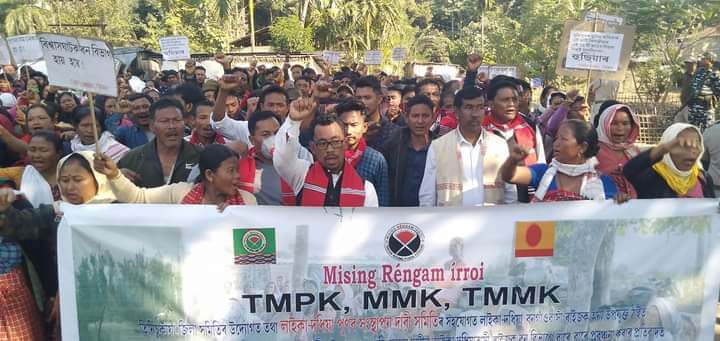
Since the Wildlife Protection Act of 1972 denies any kind of human habitation within a recognised national park, the government and the forest department have denied every basic human right to the villagers residing in Laika and Dodhia.
“We are refugees in our own land”
With a magnitude of 8.6 on the Richter scale, the Assam-Tibet earthquake in 1950 destroyed tiny villages and rendered thousands of people homeless in Assam. As the government began its rehabilitation efforts, the displaced villagers of the Murkongselek area were rehabilitated in Laika, a cluster of three villages, in the Tinsukia district. Those displaced in Ockland were rehabilitated in Dodhia, a cluster of four villages in Dibrugarh district. Laika and Dodhia were forest villages which came under the Dibru Reserve Forest.
A few years later, the government began development projects in these villages. Roads were built and the locals were given a healthcare centre and the Laika Pomua L.P school. “The people were genuinely happy. They started farming, rearing cattle, and fishing. Since the area was resource-rich, they could harness it without harming nature,” Minturaj tells me. But, with the forest department tightening the laws governing these villages, tensions began soaring.
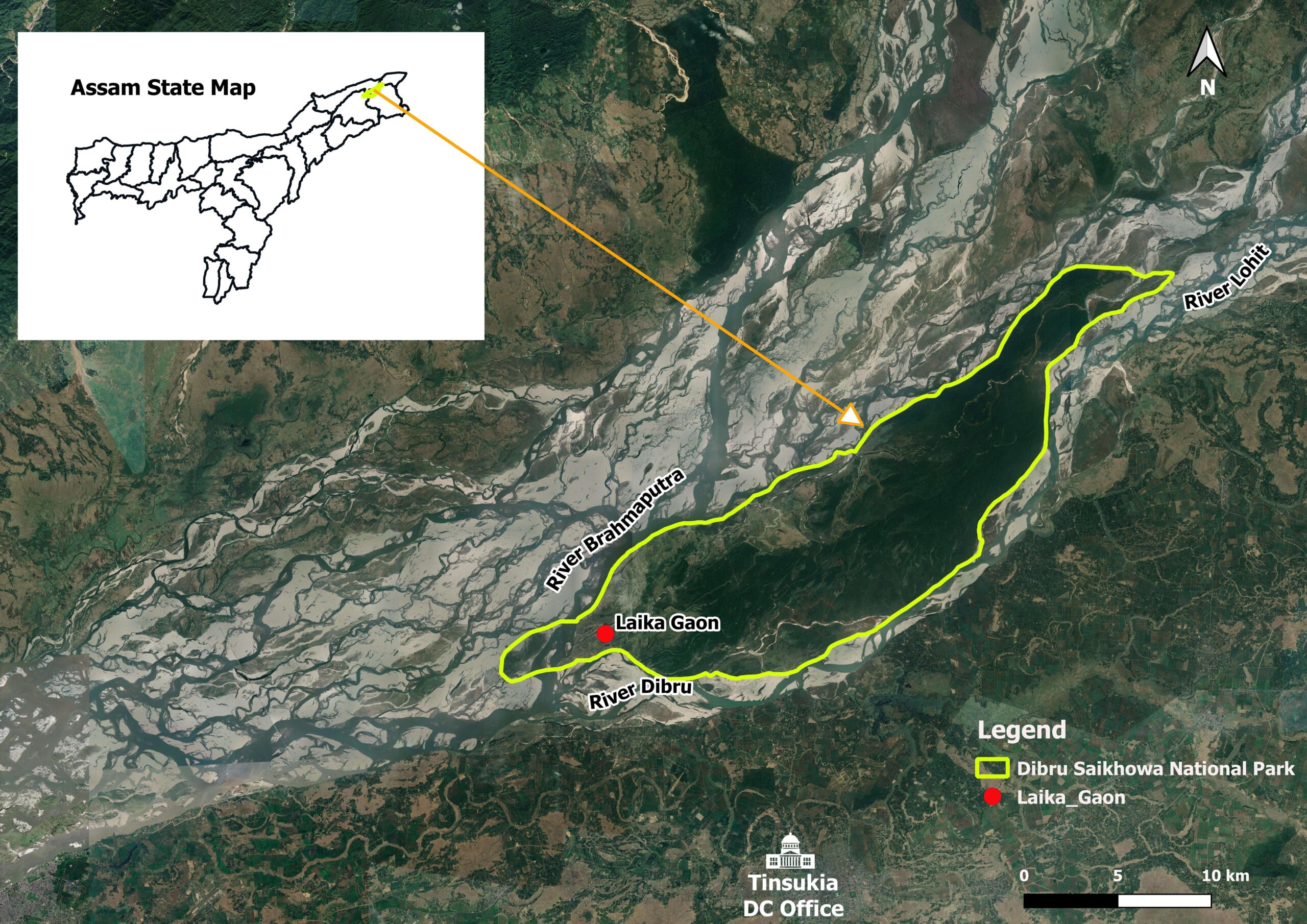
More than three decades after the earthquake, in 1986, the nearby Saikhowa forest reserve was added to the Dibru reserve. Together, they made up 640km² of what was known as the Dibru-Saikhowa Wildlife Sanctuary. The villagers expressed their discontent for not being consulted before making changes to the reserve’s boundaries, but this was only the beginning of their struggles. In 1997, after adding another 155km², the forest reserve had been declared to be a ‘Biosphere’ reserve.
Two years later, in 1999, after including lands on its periphery, the Dibru-Saikhowa reserve was declared to be a National Park. This new nomenclature and the steady expansion of the forest’s boundaries completely changed the relationship between the surrounding settlements and the natural resources which were their source of livelihood.
“We were physically present, but the records did not show so”
“Because they needed the funds from UNESCO, the Assam forest department cleared all records of Laika and Dodhia villages’ existence. If human settlements were recorded, it would not be possible to declare the reserve as a National Park,” says Ajay Doley, the 31-year-old Assistant General Secretary of TMPK Tinsukia District. Like Minturaj, Ajay is also a law student and has closely studied the legal documents of these processes.
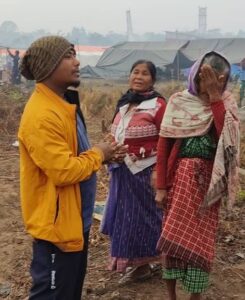
“By neither consulting us nor informing us about these developments in the forest laws, the forest department and the Assam government has violated our fundamental rights,” adds Ajay. Now that the area comes under the ambit of the Wildlife Protection Act 1972, no human settlement is allowed inside the Dibru-Saikhowa National Park.
“The Assam government could do two possible things. They could compensate us for our losses, or they could resettle us to a newer, and safer location. But, the government has not shown any interest in either of these solutions,” laments Ajay.
As of now, all government-led developmental initiatives seem to have stopped. Livelihood activities like farming, grazing and fishing have become illegal. “Nobody even knew that we were living here, in these forests,” says Minturaj. “There could be a murder, and nobody outside of our community would come to know about it. Even we did not know what was happening outside [of our village]…. it wasn’t easy for us to exit and enter past the forest boundary,” he adds.
The residents of Dodhia and Laika villages have also been under a constant threat of flooding in the forests. Surrounded by the mighty Brahmaputra to the north and the Dibru river to the west, they would lose property, cattle, and their farmed lands when flooding occurred. Unlike with the earthquake in 1950, these days, there is no government to turn to for help. The village lost four primary schools and one upper-primary school to flooding in 2017. “We built temporary tents as schools, but even the teachers were hesitant to come to these interior villages. They were not willing to risk crossing the rivers and dense forest to teach our children,” says Ajay. Very soon, classrooms with children became an irregular feature.
The last resort of the residents of Dodhia and Laika villages has been to come out and protest for their fundamental rights to be recognised, and to hold the government responsible for their rehabilitation.
A Tale of Protests Spanning Over Two Decades
In 1999, Nature’s Beckon, the organisation that led the movement to recognise Dibru-Saikhowa Wildlife Sanctuary as a National Park, also led a movement to rehabilitate the villagers of Laika and Dodhia. Along with the villagers, Nature’s Beckon negotiated with the then Tarun Gogoi-led state government for rehabilitation. A barren land in the Sadiya region was proposed and subsequently rejected by the villagers for being unliveable. Negotiations ensued, but with little progress.
In 2005, the villages of Laika and Dodhia came under the scanner of Operation Bajrang, a counter-insurgency operation against Assam separatist groups, particularly the United Liberation Front of Assam (ULFA). For a month, both villages were put under house arrest.
“During that time, several atrocities were committed against the villagers. Many were assaulted, tortured and even shot by the armed forces. There was also a case of rape of a woman. This led to a mass protest by the villagers to put an end to the operation in our villages. It was led by a powerful leader, Niranta Gohain, and was supported by Minturaj Morang,” Ajay tells me.
“The first protest which I took part in was in 2006. It was close to being a success. We thought that we would be rehabilitated… but the officials resorted to hard-handed measures. Many TMPK leaders were arrested. My friend Niranta Gohain was arrested, and I had to flee,” says Minturaj. He returned after a few months only to see that the protest was unsuccessful.
Yet, the movement continued under the TMPK. Although the demands for rehabilitation remained, there were no strong protests. The movements were short-lived, so little substantial developments were born from them. This was until 2017, when another big movement kicked off.
The Sarbananda Sonowal-led BJP government in 2016 allocated ₹10 crores (in their very first budget session) towards the rehabilitation of the Dodhia and Laika villages. High hopes were pinned on the Chief Minister because he too belonged to the same region. But, yet again, nothing happened. In July 2017, a determined TMPK started another protest; this time, it was led with more vigour. The result came in the form of an official letter signed by the forest department which promised rehabilitation in the forest reserves of Tinsukia and Dibrugarh within 8 months of the signing date. The chosen area was under the Tarani Reserve Forest, in the Tinsukia district.
You May Also Like: Where Do Communities Go When Areas are ‘Protected’?
“The communities there were hostile to us. They didn’t want us to build our settlements even though we were choosing land outside their settlement. Tempers flared, and violent outbreaks were swiftly managed by the authorities. Thereafter, we had to negotiate with the officials to allocate some other place, which never happened,” says Minturaj. The villagers then decided to boycott the panchayat elections of 2018. CM Sonowal promised to personally look into the rehabilitation process once the elections would be complete, but again, nothing came of it.
The villagers faced destructive floods between 2018 and 2020. “We were left with nothing [after the floods],” says Minturaj. “We had to force ourselves to move to the periphery of the National Park to survive, and now we can’t go back to our villages. We are under constant threat from the forest officials. They can arrest, detain or even shoot us if we try to enter our villages”.
“We will protest until we get what is rightfully ours”
“This time, we decided to make it a prolonged protest. [In December 2020], we went from village to village and spoke to the people about the movement. A decision was made to shift to the Tinsukia district headquarters and protest until we receive our due,” says Ajay. If the history of these villages is anything to go by, this new movement was never going to be an easy fight.
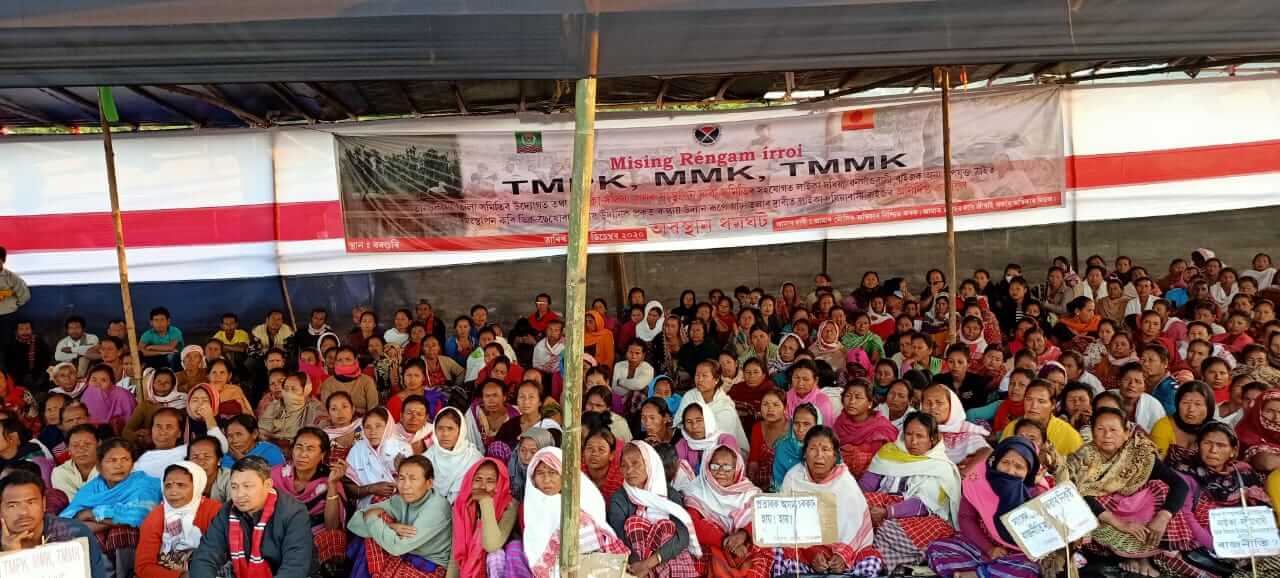
“In the first three days, we were worried. The District Commissioner threatened to arrest us, and he only granted permission for 100 people to protest. So, our leaders stayed at the back. But, very soon, when people started joining the protest, [the officials] had to give in,” explains Ajay. “Now, we have at least 2000 people here”. Members take turns moving between the protest sites and their homes. At least one member from every family is present at the protest site on a given day.
On December 30, 2020, the TMPK leaders met with Chief Minister Sarbananda Sonowal for what was the ninth time since his swearing-in, to negotiate for a fresh rehabilitation proposal. The CM then set up a high-level committee to complete their rehabilitation by January 31st, 2021. Consequently, on January 5, 2021, a new proposal was introduced by the Assam government. Yet again, the proposal was met with rejection by the TMPK leaders, who raised multiple objections.
“The locations proposed were unsuitable for us,” explains Ajay. “The first location, which is the Namphai Forest reserve in Jagun range, already has other tribal populations who themselves were displaced by flooding. We do not want to encroach into their lands. The second suggested location, which was the Adhkhona region under the Harmuti range in Lakhimpur district, is severely flood-prone. We would be worse off living there,” he adds.
The government had also proposed rehabilitating the villagers to the Paharpur tea gardens. “Paharpur in itself is disputed land. Over 1000 bhigas [in Paharpur] have been illegally encroached by businessmen for tea plantations, which is the same area that the government has proposed to us. We will only accept it under the condition that the government clears the tea gardens and gives us protection for at least a year,” Ajay says firmly.
So what other options exist for the villagers of Laika and Dodhia? The TMPK has proposed three locations in reserve forest ranges for their rehabilitation. The first is in Owguri, the second in Mamorani, and the third option in Tokopani.
Situated in the Upper Dehing reserve forest of the Digboi range, 470 hectares in the Owguri region was proposed by the TMPK after it had been declared to be degraded forest. But, the Principal Chief Conservator of Forests declined their proposal on the grounds that relocating to Owguri would lead to the deforestation of 8000 to 10,000 trees in the area. “This is a dubious reason,” says Ajay. “When the Divisional Forest Officer has declared that it is a degraded forest, it means that the place does not have many trees. Now, when the Principal Conservator cites this huge number of trees, one cannot help but question the intent. Are there any hidden agendas here?”
“We are citizens of this country, living without rights”
The children in the Mising community are probably the most affected by these politics; although the adults of the community pin their future hopes on these children, they have very few resources at their disposal. Given the condition of schools (or lack thereof) and the irregular visits by teachers, the literacy rate is very low amongst these two villages. “Hardly 5 percent complete their graduation, and only about 10 percent finish the 12th standard. Aspiring students have to move to Tinsukia town to complete this, which only a handful can afford. This also affects employment opportunities. Only 1-2 percent of our villagers enter government jobs. When there is no education, there can be no question of jobs,” says Ajay with a deep sigh.
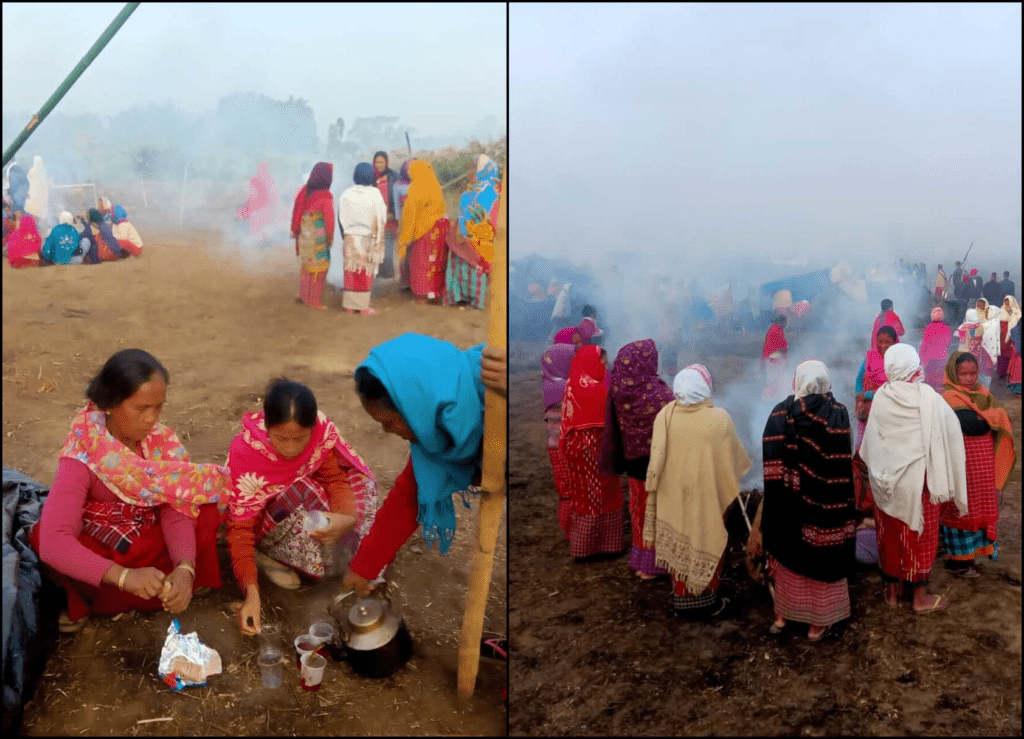
The lives of nearly 12000 Mising community members have been in jeopardy because of the government’s push to demarcate the forests as a National Park. Ajay and Minturaj both believe that their communities have been made to feel like second-class citizens, what with being forced to beg for their basic rights.
We are the citizens of this country. We are the children of this soil. For decades, we have been peacefully protesting for our own rights. Yet, we are made to struggle so much. We never degrade the forest or damage its resources. In fact, the forest is holy to us. We keep a check on outsiders and fight against people who try to exploit [the forest]. Ironically, today, we are being termed as ‘encroachers’. We have promised the government that we will plant new trees for every tree that is cut for our rehabilitation. Our communities cannot live without the forests.
— Minturaj Morang
Not only is their fight against the State, but the Mising community is also being forced to fight against other communities in their search for a secure space to settle. While the government continues to make ‘proposals’, even after witnessing 25 days of protests led by women, children, and the elderly, all in the freezing winter. Nevertheless, the Mising are determined to have their rights recognised before they go back to their homes near the National Park. “Our community is dependent on us. They are waiting for us to go back with positive news. We cannot disappoint them this time,” a determined Ajay adds.
Minturaj and Ajay were interviewed telephonically by the author | All images courtesy Minturaj Moreng.





